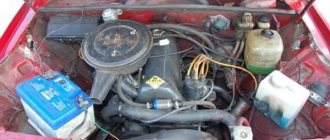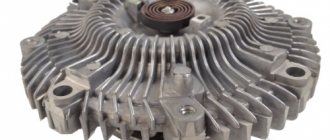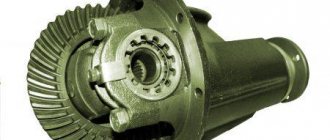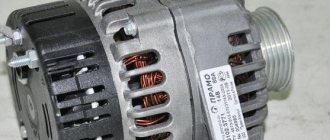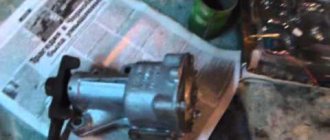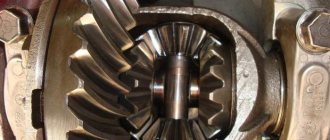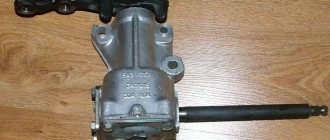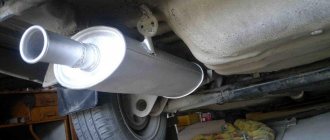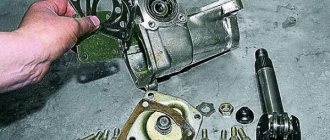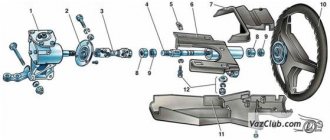A manual gearbox (MT) is designed to convert and transmit torque from the engine to the vehicle's transmission with a stepwise change in gear ratio.
Models of the Volzhsky Automobile Plant were equipped with four and five-speed gearboxes. The VAZ 2107 began to be equipped with a five-speed gearbox in 1982. This box is one of the successful design solutions of “classical” mechanics.
Like all mechanisms that have rotating and rubbing parts, the gearbox is also subject to intense wear. The structure of the unit is complex, so maintenance and repairs are best done in specialized workshops with the assistance of trained personnel.
Although every car enthusiast who knows how to hold a tool in his hands, having studied the device and the procedure for performing work, can carry out maintenance and repairs in his garage.
Five-speed manual transmission
The seventh model Zhiguli has a five-speed gearbox with five forward speeds and one reverse.
It is made of duralumin and has similar covers on the front and back. The clutch cover is attached to the front of the box using studs. A steel cover is installed on the bottom of the device. There are sealing gaskets between the box body and each lid.
The front cover is connected to the clutch housing using a press fit. There is a hole in it for the input shaft to exit and install the cuff.
Inside the box, shafts with gears, synchronizers and gear shifting devices are installed in a certain order. There is an oil filler hole on the right, and a drain hole with a magnetic plug on the bottom.
At the bottom left of the cover comes the speedometer cable, which is driven by the secondary shaft using a gear.
The gear shift lever is on top. Consists of a gear selection device, rods and a locking mechanism. A handle is attached to the lever on top. This entire structure is attached to the lid using three studs.
Type of gearbox:
- Clutch cover.
- Breather.
- Box body.
- Rear cover.
- Gear shift lever.
- Lever housing.
- Coupling flange.
- Screw.
- Speedometer drive.
- Tray cover.
- Hole for filling.
Exploded parts:
- Fork for engaging 3rd and 4th gears.
- Fork for engaging 1st and 2nd gears.
- Fork fastener.
- Engraving washer.
- Fork rod for engaging 1st and 2nd gears.
- Rusk.
- Fork rod for engaging 3rd and 4th gears.
- Gear shift lever.
- Fork rod for engaging 5th gear and reverse.
- Rusk.
- Rusk.
- 5th gear and reverse detent spring.
- Retainer cover with gasket.
- Retainer springs.
- Ball retainers.
- Fork for engaging 5th gear and reverse.
- Sleeve.
Moving parts of the gearbox:
- Intermediate shaft.
- Front intermediate shaft bearing.
- Rear main shaft bearing.
- Input shaft with 4th gear gear.
- Synchronizer clutch for 3rd and 4th gears.
- Synchronizer clutch hub.
- Synchronizer clutch for 1st and 2nd gears.
- Synchronizer clutch hub.
- Front secondary shaft bearing.
- Secondary shaft.
- Intermediate bearing of the secondary shaft.
- Rear secondary shaft bearing.
- 5th gear synchronizer clutch.
- Synchronizer clutch hub.
- Reverse gear.
- Gear with 5th gear synchronizer.
- Speedometer drive gear.
- Gear block for 5th gear and reverse gear.
- Gear block bearing.
- Reverse intermediate gear.
- Reverse idler gear axis.
- Rear intermediate shaft bearing.
- Gear with 1st gear synchronizer.
- Gear with 2nd gear synchronizer.
- Gear with 3rd gear synchronizer.
Gear shift drive diagram:
| 1 – gear selection rod lever; | 10 – hinge bushing; |
| 2 – gear selection lever; | 11 – hinge tip; |
| 3 – gearbox housing; | 12 – clamp; |
| 4 – clutch housing; | 13 – protective cover of traction; |
| 5 – gear selection rod; | 14 – gearbox control drive rod; |
| 6 – rod bushing; | 15 – gear shift lever; |
| 7 – rod seal; | 16 – ball joint cage; |
| 8 – protective cover; | 17 – ball joint of the gear shift lever; |
| 9 – hinge body; | 18 – jet thrust. |
The gearbox control drive consists of a gear shift lever (15), a ball joint (17), a rod (14), a gear selection rod (5) and gear selection and shift mechanisms (crumpled “P”).
To prevent spontaneous switching off of the P due to the axial movement of the power unit on its supports when the vehicle is moving, a reaction rod (18) is introduced into the gearbox control drive, one end of which is connected to the power unit, and a clip (16) of the ball joint of the lever (15) is attached to the other end ) switching P.
A lever (1) is attached to the inner end of the rod (5), which acts on the three-year lever (2) of the P selection mechanism. This mechanism is made as a separate unit and is attached to the plane of the clutch housing.
Gear ratios at the gearbox
The seventh model of the Zhiguli received a good version of a five-speed gearbox. The designers of the Volzhsky Automobile Plant took a box from a VAZ 2105 as a prototype, replaced the gear ratio of the main gearbox pair from 4.3 to 4.1, then to 3.9 and obtained the following gear ratios.
| home | 1st gear | 2nd gear | 3rd gear | 4th gear | 5th gear | Reverse |
| 4,1/3,9 | 3,667 | 2,100 | 1,361 | 1,000 | 0,820 | 3,530 |
The gear ratio is the ratio of the number of teeth on the driven gear to the number of teeth on the drive gear.
Primary shaft
The input shaft transmits torque from the engine crankshaft through the clutch disc to the gearbox. The disc is located on the splines of the front part of the shaft. A constant mesh gear is rigidly mounted on the shaft.
For free rotation, it is placed in two bearings. One bearing is located at the end of the crankshaft, the other is in the front cover of the gearbox.
Secondary shaft
In a complex gearbox mechanism, the secondary shaft is the final stage in converting torque and transmitting it to the cardan. The gears of the first three speeds move freely on this shaft. At a certain gear, they engage with the intermediate shaft gears and provide the required torque.
The shaft is placed in bearings, there are three of them. One is pressed into the end of the input shaft, the other into the box body, and the third into the rear cover.
Intermediate shaft
The intermediate shaft transmits rotation from the primary shaft to the secondary shaft.
He plays the role of a satellite. The gears and shaft are made from a single piece. It is installed on three bearings. The gears for fifth and reverse speed are located on it.
Forks
In the process of switching speeds, forks are involved, which move gears along the shaft to a certain place.
The gear shift lever moves the forks.
Characteristics of all types of Lada Granta gearboxes
The first manual transmission of this sedan and liftback class model received the index 2180. It was soon replaced by a modernized cable-driven gearbox, which is indexed as 2181. It is installed starting with the “standard” configuration.
Traction and cable gearbox Lada Granta
The difference between these two checkpoints is obvious. The first and most important thing is to use, instead of rigid rods that increase vibration on the body and rocker, more flexible cables from the Japanese manufacturer Atsumitec. In addition, gearbox 2180 differed from 2181 in other parameters.
- The 2181 has cone-shaped synchronizers, which reduces the impact on the gear lever when setting 1st or 2nd speed.
- The clutch disc has become larger in diameter (215 mm). Because of this, the clutch housing increased in size, and the starter began to be located along the internal combustion engine.
- The synchronizers received teeth with a reduced angle bevel (100 degrees), and the initial preload force was reduced to 70 Nm.
- A different mechanism for selecting speeds was developed by Schaeffler. In addition, it was moved upward, which made it possible to reduce the effort when switching in cold weather and eliminate oil smudges.
- The clarity of gear shifting is made possible, among other things, thanks to the selector plate.
- Instead of mineral gear oil, semi-synthetic oil was used from the factory, and the oil volume was reduced to 2.2 liters.
Structurally, the gearbox has become not only more reliable, but also more comfortable for the driver. Vibrations to the gearshift lever and the body as a whole have decreased significantly. The speeds began to turn on clearly and without delay. At the same time, the modernization of the gearbox on the Lada Granta and Kalina 2 entailed an average increase in price by 5,000 rubles. According to experts, the main difference between the updated transmission is not so much in reliability, but in the quality of gear selection.
What is characteristic is that the new editions of the Lada Priora did not receive a cable gearbox; this car is still equipped with an outdated VAZ 2180 with rigid rods.
Features of a robotic gearbox
In addition to the updated mechanics, the Lada Granta since 2015, starting with the “luxury” configuration, can be equipped with a robotic gearbox. The new transmission will be available in “standard” and “luxury” variations. According to the engineers, this device should completely eliminate the negative impact of the human factor, in which various errors are made.
Granta became the first car of the VAZ family to receive a robotic transmission option. The main manufacturer was the Japanese company Jatco, known in its field for the development and production of robotic, automatic transmissions and CVTs. They began installing a 4-speed gearbox, proven over the years, on the Grant. Not the most modern, but reliable.
Features of automatic transmission
The period of adaptation of the robot and the release of the first pilot versions of Granta on the machine lasted quite a long time. During this time, the symbiosis of domestic and Japanese developments was subjected to numerous calibrations. The modernization included about 30 modifications, and engineers from Austria were involved in the process. Only after this did the automatic transmission go into production.
Experts even took into account ergonomic issues: the hand fits comfortably on the gear shift lever. The selection of the appropriate modes is indicated on the selector; the specified mode is also duplicated on the BC screen. The only drawback revealed during operation is the unreliable fixation of the lever in the selected mode.
The gearbox operates in several modes. First and second gears are fixed. There is an overdrive button, thanks to which the automatic transmission will not switch to fourth speed. This mode is relevant when overtaking on the highway. Fixed first two gears are used for off-road driving or long uphill climbs. In winter, the transmission will not engage in higher 3rd and 4th gears until the oil warms up to 15 and 60 degrees, respectively.
Unlike the manual transmission of the Lada Grant, the automatic transmission does not have a flywheel. A drive disk is used instead.
Features of the automatic transmission scheme led to a decrease in the vehicle's ground clearance. The electronics that control the device are located behind, on the left side below the headlight. Many believe that such a location will lead to uncontrollability of the car in an accident. But engineers think differently. Automation will reliably control the work. Judging by the reviews, the system really functions flawlessly, and this is good news.
Technical characteristics of manual transmission
In the operating instructions, the technical characteristics of the box are indicated together with the characteristics of the transmission. This is given in tabular form:
| Clutch | Single-disk, dry with hydraulic drive and central diaphragm spring |
| Transmission | Mechanical, five-speed, three-way, three-shaft, with synchronizers on all forward gears |
| Gear ratios | |
| First | 3.667 |
| Second | 2.100 |
| Third | 1.361 |
| Fourth | 1.000 |
| Fifth | 0.820 |
| Reverse | 3.530 |
| Cardan transmission | Twin-shaft with intermediate support and elastic coupling |
| main gear | Hypoid |
| Final drive ratio | 3.9 or 4.1 |
| Differential | Conical, two-satellite |
The car doesn't move forward
Usually in this case the reverse gear works properly. The cause may be damage to the discs or piston cups. Another common case is a stuck shift adjustment valve.
To troubleshoot problems, it is necessary to replace the friction discs, change the cuffs and clean the valve. If the reverse speed does not work either, it means that the culprit of the problem is the clutch responsible for the forward speed. Excessive wear will destroy the O-rings, spline mechanism and coupling. Repair in this case will consist of replacing damaged and worn elements.
The car does not move forward or backward
The absence of any movement can, in principle, be caused by the following malfunctions:
- failure of the torque converter;
- problems with the oil pump;
- low oil level;
- the strainer is clogged;
- damage to friction discs;
- rupture of the cuff and o-rings;
- The forward valve is stuck.
In these cases, a complete replacement of worn parts will be required. Often the car can move forward, but when moving away there is a strong jolt. The car starts to slip and then stops. This problem indicates low oil level, failure of the torque converter or oil pump.
Other malfunctions and methods for eliminating them
Sometimes the breakdown is the absence of all speeds, except for the first. This indicates several problems: the valve is stuck, the teeth of the helical gear are damaged, or its cotter pin is sheared off. Troubleshooting work involves replacing worn parts, cleaning the valve, and checking the valve system.
A low oil level leads to other consequences in addition to the impossibility of movement. For example, when driving uphill for a long time, engaging a higher gear leads to slipping. The reduced mode is automatically switched on. Damage to the cuff and O-rings is also possible.
When switched to the “neutral” position, the car continues to move. This means that the drive cable is not adjusted. Or the drive lever or clutch is jammed, or the friction discs are damaged.
Very often, automatic transmissions encounter a problem called “kickdown,” i.e., when the gas pedal is sharply pressed, the gearbox does not shift to a lower gear. The problem most often occurs due to a pressure sensor, damaged foot switch, broken wiring, or poor adjustment of the throttle drive. Eliminated by replacing the sensor and adjusting the drive.
In fact, theoretically there can be a lot of problems. To the point where water gets into the gearbox housing and the oil foams, causing the car to start slipping. Subsequently, in advanced cases, this leads to complete failure of the gearbox.
An automatic transmission, like a robotic one, is much more complex than conventional mechanics. Service is not cheap, but repairs at home cannot be carried out efficiently.
It is important for car owners to learn how to correctly diagnose faults, and if they are minor, fix them themselves. If the problem is related to the need to remove and disassemble the automatic transmission, in such cases you cannot do without the help of qualified specialists. Repairs, depending on the complexity and malfunction, are estimated at an average of at least 2–3 thousand rubles, although it can reach up to 15–20, not counting the cost of spare parts.
What kind of gearbox can be installed on a VAZ 2107
Initially, the “Seven” was produced with a “four-speed”, so you can install any VAZ gearbox from rear-wheel drive “Zhiguli” on it. You should know what functions the car will perform. If you use it as a workhorse, carry loads, pull a trailer, then a four-speed gearbox will do. It is more durable and resistant to variable loads. If high-speed driving on highways is necessary, then a five-speed gearbox is suitable.
It is possible to install boxes from foreign cars.
The best option is a box from an Italian Fiat model, since this is a prototype of our VAZ.
You can also install it from an early model BMW, but for installation you will have to redo the fastenings.
Transmission malfunctions
The box on the seventh model Zhiguli is considered a reliable unit. If you maintain it regularly and treat it with care during operation, then repairs will not be needed for a long time. However, all components and parts are subject to wear. There are many reasons for this. In any case, if a malfunction is detected in the gearbox, it is necessary to carry out diagnostics and repairs.
Most malfunctions occur of the following types.
One of the gears does not engage
Without opening the box, we can assume that:
- the hinges and springs are worn out and need to be replaced, or better yet, a complete repair;
- on synchronizers, the rings have become unusable and need to be replaced;
- synchronizer spring burst, replace;
- The teeth on the transmission gears are worn, replace the gear.
Knocks out gear when driving
It happens that when you turn on a gear, it does not turn off randomly. Possible reasons:
- the lever hinge is jammed, inspect and clean;
- the clutch is faulty, it may not engage completely, adjust it, if the disc is worn, replace it;
- The shift lever is broken, replace it with a new one;
- Forks, shift gears are bent, replace with new ones.
Crunching and grinding in the box while driving
This problem appears for the following reasons:
- the bearings are worn out, they should be replaced, and at the same time check the seals;
- the teeth of the gears are worn out, in this case it is better to make a major repair;
- There is not enough or no lubricating fluid in the gearbox, find the leak and fix it, add oil.
Grease leaking from box
The gearbox is designed so that lubricant cannot leak out spontaneously. But if an oil stain has formed under the car, an inspection should be made and the leak eliminated.
The reason may be:
- wear of oil seals and sealing gaskets due to natural aging of rubber must be replaced with new ones;
- the fastenings of the covers on the box have become loose, tighten all the nuts and bolts completely;
- mechanical damage to the body or lids of the box; if the steel lid is damaged, it can be welded. If the crankcase is damaged, it is better to replace it, since it is cast from an aluminum alloy.
A short summary
General structure of manual gearboxes on VAZ
VAZ manual gearboxes are very reliable, unpretentious gearboxes, their gearshift scheme is the most standard, no exotic ones. And this is a huge plus, since their maintenance and repair are just as simple and straightforward. They have to be repaired relatively rarely, since they perfectly hold the torque from the ring shaft of VAZ engines, even forced ones. For comparison, many manual gearboxes have difficulty maintaining the torque of stock engines, comparable in power to VAZ ones, and very quickly fail at the slightest increase in engine power. What makes VAZ manual transmissions so durable? Let's look at the diagram of their design and understand why they are good and what their shortcomings are.
Gearbox seals and their replacement
Oil seals in any mechanism where they exist act as gaskets. In this case, they are designed to seal the holes from which the primary and secondary shafts come out. Previously, oil seals were cast from rubber.
Currently made from modern composite materials, more resistant to temperature changes and aggressive environments.
Input shaft oil seal
The oil seal, which is installed on the input shaft, has the following dimensions:
- • outer diameter – 47 mm;
- • internal diameter – 28 mm;
- • width – 8 mm;
- • weight – 20 grams.
It is installed in the shaft output hole in the clutch housing and serves to prevent lubricant from flowing through the shaft.
There is no difficulty in replacing the oil seal, but the gearbox will have to be removed.
The order of work to change the oil seal is as follows:
- Remove the clutch cover from the gearbox.
- Remove the release bearing and clutch fork.
- Remove the used oil seal by picking it up with a screwdriver or knife.
- Clean the place where the oil seal was located and wipe it dry.
- Install the new oil seal in its original place.
- Replace all the parts that were removed from the box in reverse order.
Secondary shaft oil seal
The oil seal, which is installed on the secondary shaft, is larger and has dimensions:
- outer diameter – 56 mm;
- internal diameter – 32 mm;
- width – 10 mm;
- weight – 10 grams.
It is installed at the output of the secondary shaft at the rear of the box.
The order of work to change the oil seal is as follows.
- Unscrew the nut securing the flange, having previously secured it.
- Remove the centering metal ring from the shaft.
- Remove the flange and washer using a puller.
- Pull out the old oil seal using a tool.
- Clean and wash the seal area.
- Install a new oil seal.
Difficulty switching
Now let's briefly look at other faults. Difficulty shifting gears will be next.
The reason for this may be:
- Wear of the switching mechanism or its deformation (scenes);
- Wear, the appearance of burrs on the gear shift axles or on their seats, jamming of the crackers;
- Damage or wear of the splines of the synchronizer sliding couplings;
- Damage and bent shift forks;
In the first case, to restore functionality, you don’t even need to remove the transmission from the car, since replacing the VAZ-2105 gearbox shifter is possible without dismantling the transmission unit.
To do this, it is enough to remove the lever, boot, and plastic protective cover to provide access to the fastening elements of the switching mechanism, which must be unscrewed in order to remove the mechanism assembly. And then it is replaced or repaired.
Important! In a 4-speed gearbox, a tension spring is attached to the rod from inside the crankcase, which ensures a constant position of the lever opposite 3-4 gears and prevents its vibration. Therefore, when removing the mechanism, you should first lift it a little, and then pry the spring with a hook made of steel wire, remove it from the eye of the rod and hold it in a slightly tense position so that it does not fall into the crankcase. Before installing the new link, use the same hook to hook the spring and install everything in place.
As for other breakdowns that make it difficult to engage the gears, you will have to remove the gearbox, disassemble it, identify the worn or damaged element and replace it.
Replacing gears and synchronizers
The work of replacing gears and synchronizers is one of the most difficult when repairing a gearbox. There is a standard repair kit containing all the necessary parts to help cope with the task. It is advisable to prepare a special tool.
Gears and synchronizers on the primary and secondary shafts are changed in almost the same way.
The process goes like this:
- remove the shaft from the box;
- clamp the shaft in a vice, wrapping it in something soft;
- Remove the retaining ring from the shaft using a special tool or a screwdriver:
- press the bearings off the shaft;
- remove the shaft from the vice, place it vertically, resting the first gear on two supports;
- carefully press the gear off the shaft;
- Carry out similar operations with the remaining gears and synchronizers.
Removing and replacing the fifth gear gear occurs differently.
The video clearly shows and explains how to do this:
Speed "knocks out"
Fuzzy switching on or knocking out the speed occurs due to:
- Wear of the retainer holes in the axle, damage to its springs;
- Wear of synchronizer blocking rings, damage to its springs or wear of teeth;
In this case, it will not be possible to eliminate the malfunction without removing the gearbox. But, it is not always necessary to completely disassemble it. For example, if the 4th gear slips out, you should immediately check the condition of the spring and the lock of the axis of this speed. It is by checking the fasteners that the search should begin. And then, by disassembling the box, we identify the true cause and eliminate it.
Transmission oil for gearboxes
To select gear oil for the Lada gearbox, you need to take into account the region where the car will be operated.
Two types of oils are offered. The first - with a temperature range from +35 to -26, this is SAE 80W85 and the second - with a temperature range from +45 to -40, this is SAE 75W90.
The best oil is synthetic, but semi-synthetic and mineral oils will not harm the Seven’s transmission. The amount of oil in the VAZ 2107 gearbox is about 1.6 liters. The oil change time is carried out according to the instructions in the technical instructions supplied with the car.
Manual transmission oil level
The oil level in the box is checked as follows:
- drive the car onto an overpass or pit;
- clean the filler plug;
- unscrew the plug;
- measure through the hole with a probe or other object resembling a probe. The oil should be level with the end of the filler hole; top up if necessary.
Oil change
It is better to change the oil on an overpass or pit with a warm engine, so the oil will drain faster. Prepare the tool in advance, a container for working out at least two liters, oil for changing.
The order is as follows:
- clean the fill and drain plugs from dirt;
- Place the prepared container for used oil under the drain hole;
- open the drain hole and wait until the oil completely drains into the container;
- clean the plug of old oil and close the drain hole;
- pour 1.5 liters of new oil into the box through the filler hole (it’s better to fill it with a supercharger);
- let it sit for ten minutes, then check the level and top up if necessary.
Gearbox service
But first you should consider the maintenance that needs to be carried out on this unit. There is only one thing - checking the level of lubricant and, if necessary, topping it up to the required level.
A manual transmission itself is not demanding, so the lubricant used in it performs only one function - it lubricates the component parts of the unit. Therefore, the oil in the box should be changed every 60 thousand kilometers.
Before servicing the gearbox, you should know what kind of oil to pour into the VAZ-2105 gearbox. The transmission of this car requires gear oil with an API quality level of GL-5 or higher and a viscosity of 75W-90 or 85W-90 according to the SAE classification. The oil volume in the gearbox is 1.35 liters.
Checking the oil in the box is not difficult, but to do this, the car should be placed on an inspection hole or overpass.
And then the actions are as follows:
- On the left side of the gearbox housing (in the direction of travel of the car) we find the control filler plug (located just above the bottom cover of the box);
- Use a rag to remove dirt around the plug;
- Using a wrench of the required size, unscrew the plug;
- You can find out the level using a small mirror and a flashlight, a screwdriver or even your finger, in general, whatever is convenient. The lubricant level is considered normal if the oil reaches the bottom edge of the hole;
- If the oil level is below the level, use a technical syringe to bring it up to normal (as soon as the oil begins to flow out of the hole, tighten the plug);
Checking and adding lubricant to the gearbox should be “cold”. If maintenance is carried out immediately after a trip, it is necessary to allow time (10-15 minutes) for the oil to completely drain, otherwise the level will be incorrect when checking.
If the time has come to change the oil, then first drain the used lubricant - clean the bottom cover of dirt, place a plastic container and unscrew the drain plug.
Then wait until the oil has completely drained and tighten the plug.
And then everything is done in the same way as when checking and replenishing the level, only you will have to pump the required amount of oil into the box with a syringe.
After replacement, you should not immediately dispose of the waste; before doing so, it is better to check it. To do this, take a magnet, tie a thread and lower it into a container with old oil. Next, you should move the magnet along the bottom. Then we take it out and examine it. If a large amount of metal shavings is found on the magnet, this may indicate the appearance of intense wear, and in this case, overhauling the gearbox and troubleshooting the components will not be superfluous, since it will allow identifying and eliminating the malfunction at an early stage.

